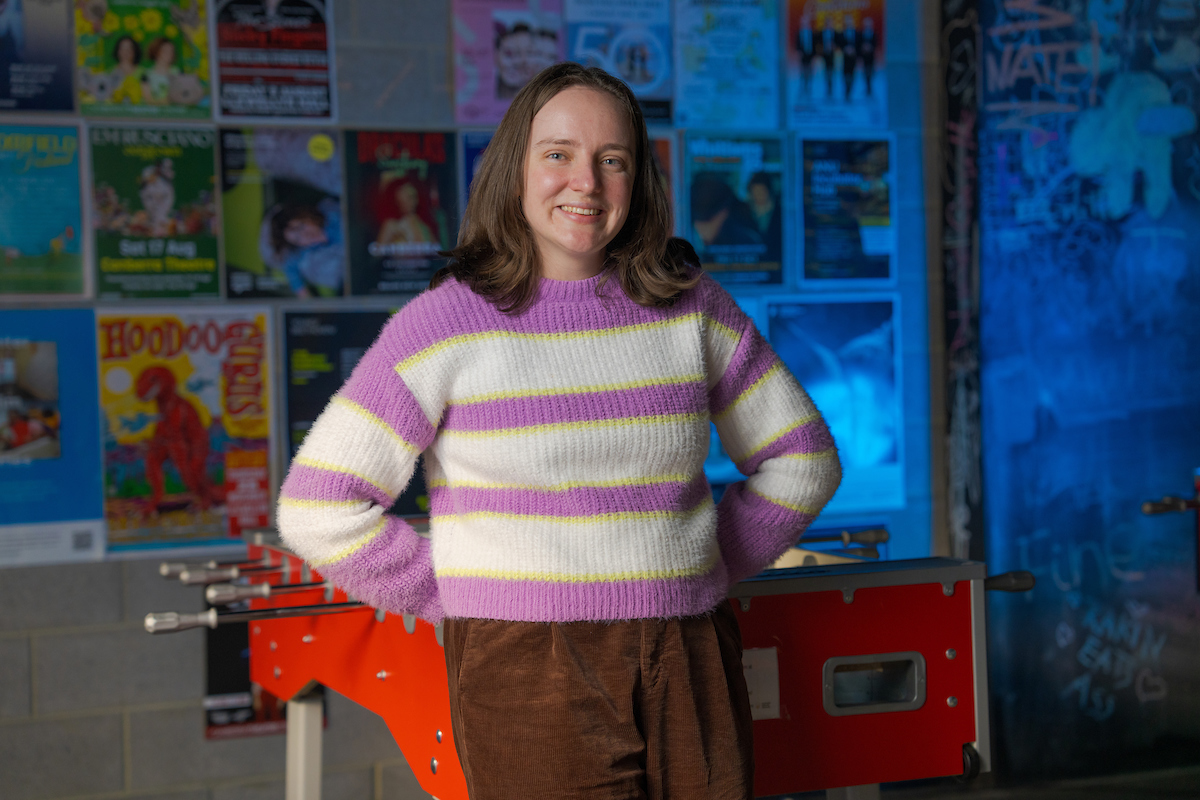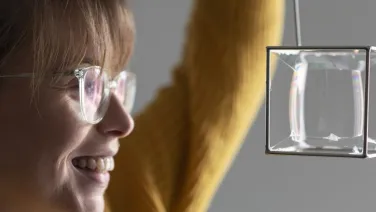The serious business of funny science

When Dr Lara Gillan visited Questacon as a child, she was too scared to drop into the infamous free fall. Now she’s returning to conquer her fears by doing something which is, in her words, “even more terrifying”.
Dr Gillan is one of six ANU scientists performing at Future Science Talks: Comedy Edition at Questacon this National Science Week. They’ve each worked with comedians to develop a talk about their research, billed as “80 per cent science, 20 per cent humour.”
The fact this terrifies Dr Gillan is the exact reason why she’s doing it. She realised she needed to push herself outside of her comfort zone to solve a very specific problem.
“My parents have no idea what I actually do every day, and a part of me is sad that this is the case,” she explains. “But it’s just so hard to break it down, so I wanted to work out how to speak to people like them who know nothing about science and on top of that, make it fun.”
To be fair, Dr Gillan is researching quantum transduction at the ANU Research School of Physics, which is a tough subject for anyone to get their head around.
In her work, she is more interested in how quantum systems can communicate with each other, than how people communicate. Solving this process may be essential for heralding a new information age powered by quantum computing, but it is not, as Dr Gillan concedes, an inherently funny topic.
This is where the other professionals come in.
In the lead up to their performance, the show’s participants have worked with David Crisante, the Director of Future Science Talks, whose expertise combines communications with comedy.
“The reality is, no matter who we are, if we’re going to tell our story to others, we need to package it in a way that is of interest to them. So it’s really important that we communicate to others based on their needs, rather than our wants.”
This presents some particular challenges for scientists, who may be exceptionally good at talking about their work with peers already familiar with the subject, but less so with a general audience.
“Our first workshop together was about how to be high level,” Crisante says. “And honestly, that is the hardest thing for the scientists to figure out: how to have a relatively narrow topic but stay high level without going into the details.”
“It was painful!” Dr Gillan remembers.
“You’re used to thinking about your research in one specific way, and there are certain words that you want to use, and those are not words that everyone knows. It’s hard to change those words and not feel like you're losing meaning.
“Some good advice from David was, even though it might hurt me to use those different terms, is it better if I’m happy with what I’ve said, or if the audience is happy with it? Because if no one understands it, then what’s the point?”
The next challenge for scientists is to add some personality.
Crisante explains that by sharing their personal relationship with their subject matter, scientists can build report with an audience.
“Because when we understand who someone is, we begin to care more about what they do.”
But in the script for her talk, Dr Gillan says at first she even struggled to use the word ‘I’.
“There is language that scientists use which is very removed, like ‘The data shows… .’ The person is entirely separated from the work they've done, so even trying to say, ‘I’m in the lab, and I do this,’ was very hard.”
An easy way to bring personality to the stage, she learned, is to show the audience that she sees herself through their eyes.
“We were asked to think about the audience’s perception of us,” Dr Gillan says. “And I’m short. So I can draw some personal elements from that, about how I'm the perfect person to build a quantum computer because I, too, come in a small package.”

But the biggest fear for scientists in the program, Crisante says, is delivering the promised “20 per cent humour”.
“A lot of them say the same thing: can you teach me to be funny? Because I’m really not funny.
“But what’s interesting is all of us are funny when we’re with our friends or our families. We crack jokes, they laugh. So we’re actually really good at it in a very specific time or situation. What we do is enable scientists to show that part of themselves to the public too, and that’s extremely liberating for them.”
But the short answer is, yes, you can teach someone how to be funny.
Through a series of workshops and a one-on-one session with a stand-up comedian, participants are taught the basic structure of how to write and deliver a joke, and coached in a range of comedic techniques.
“For example, there is something called the Rule of Three, which is a very common comedy technique,” Crisante says. “And the reason why it works so well with the scientists is because it has a very clear formula: three things, and the third thing is different from the other two.
“And simply by doing that, you delight the audience, because when you’re listing something, the audience thinks it’s going to be a normal list. With the third thing being different, we can add a playfulness.”
After completing the program, Dr Gillan isn’t quite prepared to declare herself a funny person now, but she says she does have more confidence to use the skills she’s learnt in other, more professional settings.
“It’s definitely something I want to try to maintain. For example, when I go to conferences, a lot of time by the end of the day, you can barely remember anything. I know if I can put in one little joke at the beginning of a talk, that could make the difference to getting people engaged, and also make me more approachable.
“And especially as a woman in physics as well, I would like to be more of a role model and be able to go to schools and give a talk that students can actually take something away from.”
“Being in a comedy show is over-the-top,” Crisante adds. “It’s a bit extreme, but if a scientist can do this, then they can really back themselves in any other setting.”
“I’m really glad that I’m doing this,” Dr Gillan concludes, sounding determined. “I’ll be able to say, I did it. That can be, forever, a fun fact you didn't know about me: I have done a comedy act.”
There’s just one more thing she’ll need to do after she gets off the Questacon stage. No, it’s not the free fall; it’s sending the recording of her performance to her parents.
“My hope is that they’ll watch it, and it will actually click for them, like, ‘Oh, okay, we know what you do now. Kind of.’”
Laugh and learn with Dr Gillan and other Canberra scientists at Future Science Talks: Comedy Edition as part of National Science week. Tickets are available on eventbrite.



